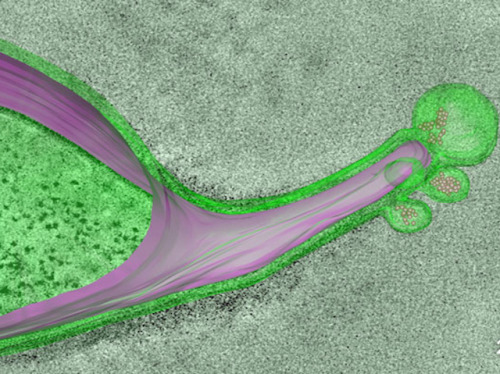
On the Hook
Our gut plays host to a whole community of microbes, including many harmless commensals, that may even be beneficial. To avoid destruction by our immune system, they need to communicate with their host’s cells, and recent research may have uncovered a way for some bacteria to do this. Segmented filamentous bacteria closely associate with the intestinal epithelial cells lining the gut, latching onto them with a hook-like protrusion (pictured, as a computer reconstruction, overlaid onto a microscopy image). Electron microscopy revealed that membrane spheres, known as vesicles, are formed where bacterium and host meet, and carry antigens, protein markers of bacterial identity, back into the host cell. Antigens are typically used by the immune system to recognise and target foreign cells, but delivering them this way may alter the immune system’s reaction, protecting the bacteria. Nicknamed MATE, this ingenious process is revealing previously-unknown mechanisms for determining friend from foe.
Written by Emmanuelle Briolat
- Image from work by the Björkman Lab, Division of Biology and Biological Engineering, California Institute of Technology, Pasadena, CA, USA
- and the Ivanov Lab, Department of Microbiology and Immunology, Vagelos College of Physicians and Surgeons, Columbia University, New York, NY, USA
- Image reprinted with permission from the AAAS — the American Association for the Advancement of Science
- Published in Science, March 2019
You can also follow BPoD on Instagram, Twitter and Facebook
Archive link



Комментариев нет:
Отправить комментарий